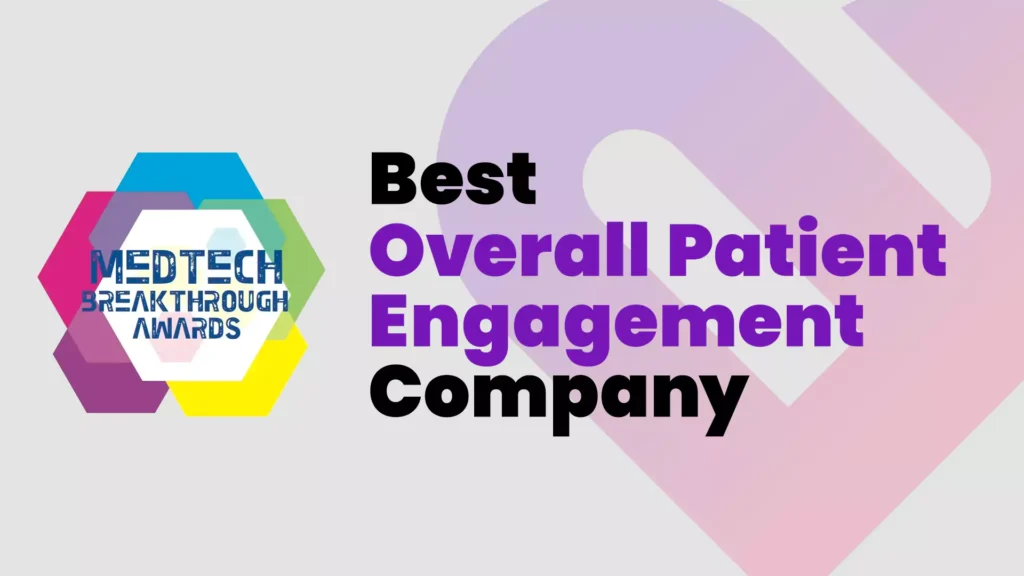At a Glance:
- Patient Communications Today: Despite patient demand for personalized and conversational communication experiences, healthcare communication trends today suggest most providers merely use basic texting to communicate simple, transactional requests to patients.
- The Impact of Patient-Provider Communications Today: Patients are left frustrated and confused because they’re often left with incomplete information from transactional requests. These broken exchanges between patients and providers lead to loss of revenue, operational inefficiencies and negatively impact patient health.
- Patient Communications Tomorrow: Patients want interactive, digital conversations with their healthcare provider and are willing to switch providers to get them. Providers who successfully bridge the divide between patient desires and a fragmented, siloed ecosystem of point solution vendors communicating with patients are expected to outpace competitors.
The healthcare industry is experiencing a transformative shift in patient communication trends, as highlighted in Artera’s recent report on “Trends in Patient Communications.” The study delves into the challenges and opportunities presented by evolving patient expectations and current communication methods’ impact on providers and patients.
The study aimed to examine the current healthcare communication trends in patient-provider interactions, including text messaging capabilities, and evaluate their impact on patient satisfaction, operational efficiencies, and the bottom line for healthcare providers. Additionally, the study aimed to shed light on patient preferences, emphasizing the growing importance of more conversational and integrated approaches to patient communication.
To better understand how patients respond to different digital patient communication strategies from their healthcare provider and the impact this has on the patient experience, Artera surveyed more than 2,000 U.S. healthcare patients who have engaged with the healthcare system over the last 12 months. The survey was conducted by PureSpectrum, an independent research market firm that gathers insights online.
Healthcare Communication Trends: Basic Texting is the Norm Today
Amidst evolving healthcare communication trends, patients are advocating for improved communication experiences throughout every stage of their care journey, from intake to post-visit follow-up and beyond. While they expect highly customized, digital experiences, providers are not always living up to these standards – in fact, this increasing consumerization is weighing heavy on providers’ shoulders.
Despite providers taking strides to improve the patient experience – including adopting advanced communication tools that enable greater access and convenience for patients – patients are often left frustrated with these experiences, most of which are basic and transactional.
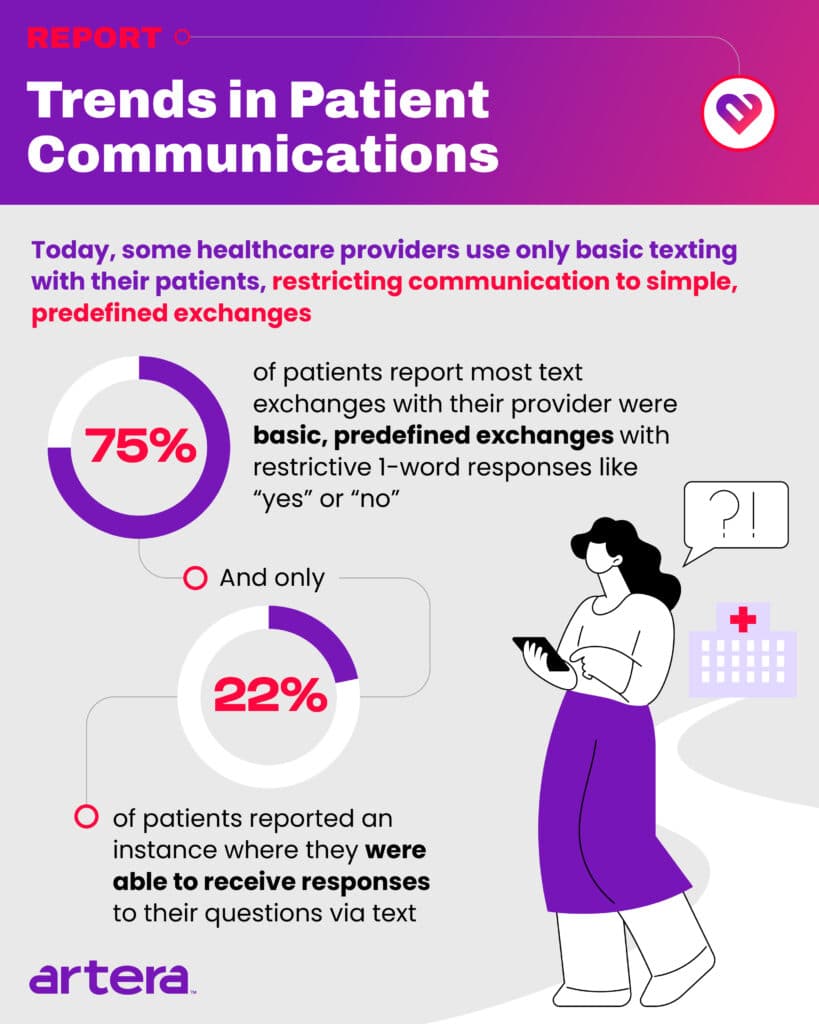
The study uncovered that, despite the myriad use cases for texting providers, a staggering 75% of patients reported that their most common text exchanges with their healthcare provider were simplistic and automated. These exchanges often limited responses to one-time answers such as “Y” or “N.” Furthermore, only 22% of patients reported an instance where they received responses to their questions via text.
Basic Texting Leaves Patients Frustrated and Unsatisfied
The lack of conversational messaging or a back-and-forth dialogue in patient-provider communication often leaves patients feeling confused and frustrated. According to the study, 69% of patients report being frustrated by this inability to engage via conversational texting with their provider. Approximately 79% of patients characterized their frustration as “moderate” or “extreme.”
These basic and transactional exchanges frequently result in incomplete experiences for the patient, with nearly two-thirds (66%) reporting instances where their expectations were unmet, leading to dissatisfaction. Almost a third (31%) indicated a failure rate of about half the time or more.
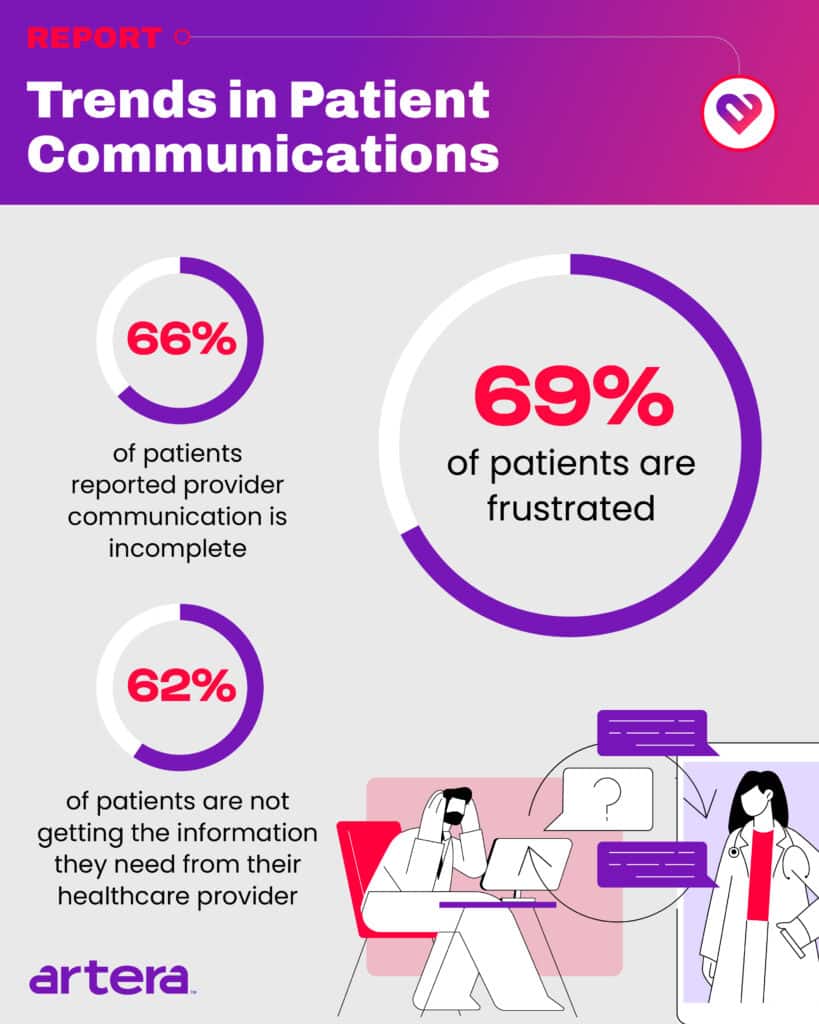
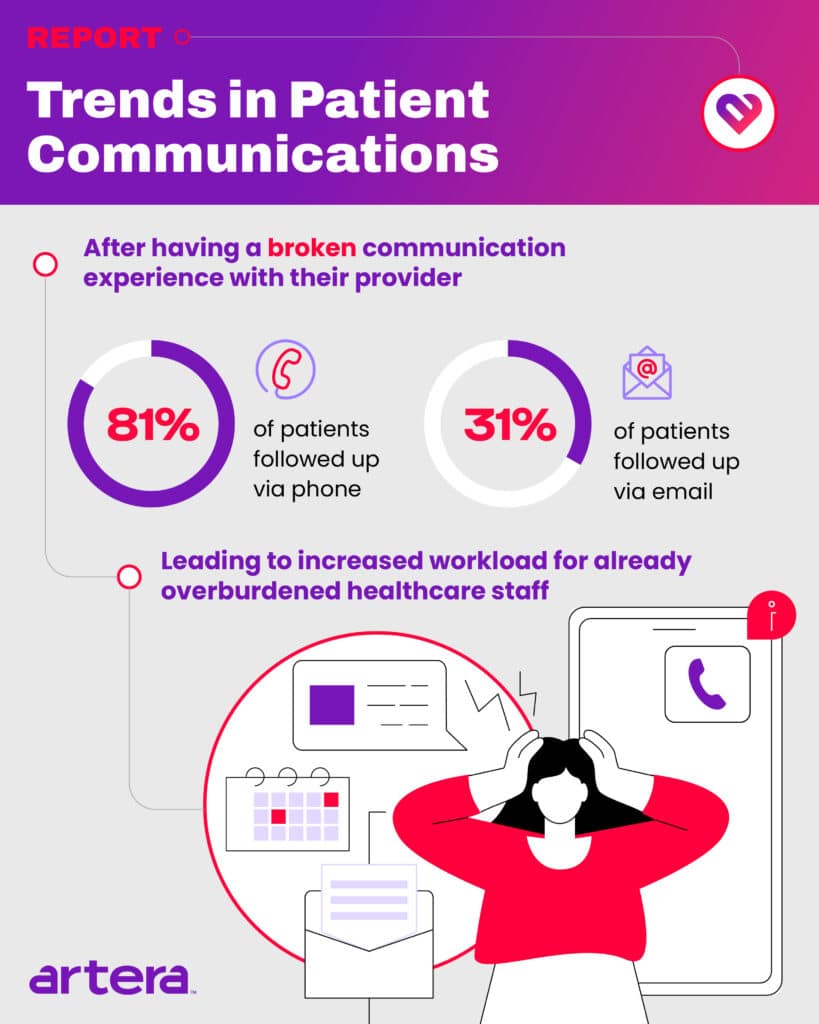
Subsequently, the responsibility is often placed back on the patient to fulfill the request, leading them to follow up via different channels or, in some cases, not at all. Of those who did follow-up, around 81% of patients reported doing so via phone, while 31% used email. Alarmingly, close to 20% of patients either abandoned the issue or attempted to follow up via another channel but failed to obtain the necessary information.
Adding to the complexity, the survey found that 68% of patients received repetitive messages from their providers across various communication channels. Additionally, 65% reported receiving a string of messages that were either out of order or jumbled. This confusion can be attributed to the fragmented landscape of Health Information Technology (HIT) vendors within healthcare provider organizations.
With limited-to-no awareness or communication of competing communication workflows or messaging backlogs, numerous digital health vendors may be independently communicating with patients at various times – resulting in communications appearing out of order and lacking context. On average, health systems have over 11 digital vendors that communicate with patients; if all of these are reaching out to patients, it’s no wonder they are feeling confused and frustrated.
“We have a huge challenge with the fact that our patients are very confused, they complain about too many messages. We have other third-party systems that message patients. The systems keep branching out and it’s a confusing experience for patients.”
Artera Enterprise Customer
Broken Patient-Provider Communication Experiences
Beyond mere patient dissatisfaction, broken communication experiences have tangible repercussions on both the physical and financial health of patients and provider organizations.
- Operational Inefficiencies: When patients experience broken communication exchanges and decide to follow up with the provider again via phone or email, they create more work for internal staff. Ultimately, this leads to an increased workload for an already overburdened healthcare staff (71% of clinical support staff reported phone-based patient communication as a source of frustration) and mounting pressure for providers grappling with workforce shortages (47% of the current healthcare workforce is planning to exit the industry by 2025).
2. Revenue Loss: Due to difficulties communicating with providers’ offices, 45% of patients reported missing or forgetting to pay a bill, which translates to lost or delayed revenue. When providers aren’t delivering on patient communication expectations, they are expected to experience patient leakage. In fact, 59% of patients reported they are willing to switch doctors if they are provided with a broken communications experience. This could be detrimental for providers as the cost of losing just one patient for a health system could amount to $1.4 million over the patient’s lifetime.
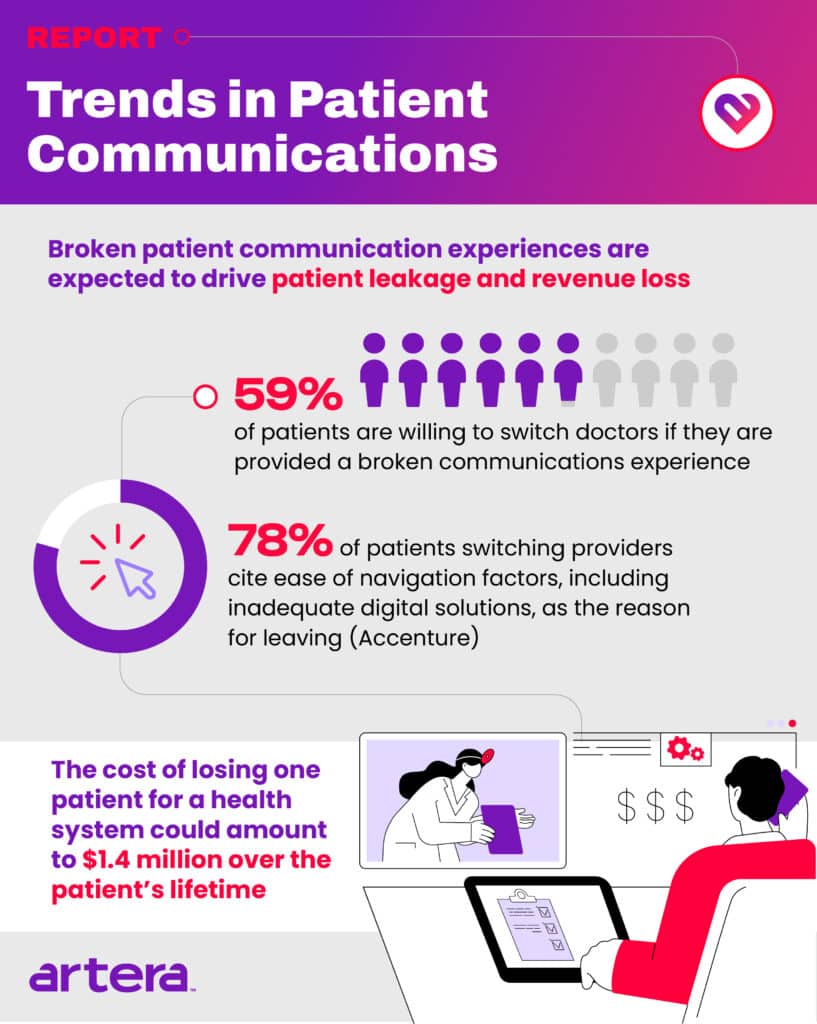

3. Negatively Impact Patient Health: Patient-provider communication challenges pose a genuine threat to patient health, with 43% reporting adverse impacts. This may result from an inability to schedule appointments or missing crucial health information. Additionally, it contributes to overall dissatisfaction with the healthcare system, an industry currently ranked in the bottom third of all industries in terms of customer service.
According to the study, younger patients are particularly susceptible to frustration arising from broken patient-provider communication experiences. They are more likely to report frustration, miss medical bills, and experience adverse health impacts due to communication challenges. As patient expectations continue to escalate, especially among the younger, tech-savvy population requiring more healthcare as they age, providers must address these variances promptly. Failure to do so may lead to an increasing number of younger patients switching providers if their expectations are not met.

Healthcare Communication Trends: Patients Want Conversational Messaging – and a Variety of Channels
When asked which messaging experience – conversational versus basic – patients preferred, 64% reported preferring a conversational messaging experience over a basic one. A majority of patients (78%) rated a conversational messaging experience as “excellent” or “good” and 79% reported wanting their provider to improve their healthcare experience by enabling them to initiate a text-based conversation on any topic.
Compared to basic, transactional text exchanges, interactive, conversational messaging experiences offer several benefits including message customization, the ability for human inclusion, a range of workflows, and messages sent via long code (provider-enabled phone number that is recognizable to patients).
What’s more, the study found that patients are not monolithic – in fact, they want diversity in their communication channels, depending on the context. Whether it was for coordinating care, billing issues, test results, prescriptions, pre- and post-appointment instructions or intake forms, patients split their preferences across phone and digital channels to communicate with providers. For example, for pre-appointment instructions, 30% of patients reported wanting to communicate via phone, 25% via text, 25% via a portal, and more.
Without an omnichannel approach to communications, providers may be missing opportunities to better engage their patients via the channels they prefer. Based on research in a recent Artera Data Insights whitepaper, our team found that 17% of patients use landlines only, so some providers may be excluding this significant segment of their patient population.
Providers Must Adapt to Thrive
Overall, the study found that not all methods of digital communication and texting are created equal, and providing simple, transactional text experiences will not necessarily deliver on the high expectations of patients today.
Now more than ever, it’s important for providers to develop a patient-centered communication strategy that goes beyond basic exchanges. Based on the findings of this study, there remains significant room for improvement for providers to enhance their digital patient communication strategy. Healthcare providers that prioritize and implement new strategies across their tech stack to deliver improved patient communication experiences will succeed — operationally and financially.
Patients are telling us they want better conversations and they deserve it. Now is the time to not only listen to healthcare communication trends but invest in your patient communication strategy. Artera is committed to delivering the best patient communications experience possible. We help more than 800+ healthcare providers and federal agencies deliver better conversations every day. Learn how we do it at www.artera.io.

